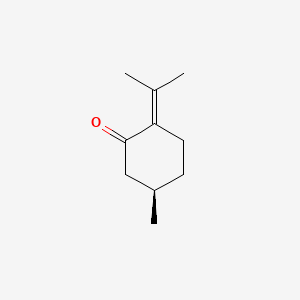| MeSH term | MeSH ID | Detail |
|---|---|---|
| Body Weight | D001835 | 333 associated lipids |
| Endophthalmitis | D009877 | 12 associated lipids |
| Uveitis, Posterior | D015866 | 5 associated lipids |
(+)-Pulegone
(+)-pulegone is a lipid of Prenol Lipids (PR) class. The involved functions are known as Excretory function, conjugation, Competitive inhibition, radiochemical and Synthesis. (+)-pulegone often locates in Microsomes. The associated genes with (+)-Pulegone are 4S-limonene synthase.
Cross Reference
Introduction
To understand associated biological information of (+)-Pulegone, we collected biological information of abnormalities, associated pathways, cellular/molecular locations, biological functions, related genes/proteins, lipids and common seen animal/experimental models with organized paragraphs from literatures.
What diseases are associated with (+)-Pulegone?
There are no associated biomedical information in the current reference collection.
Possible diseases from mapped MeSH terms on references
We collected disease MeSH terms mapped to the references associated with (+)-Pulegone
PubChem Associated disorders and diseases
What pathways are associated with (+)-Pulegone
There are no associated biomedical information in the current reference collection.
PubChem Biomolecular Interactions and Pathways
Link to PubChem Biomolecular Interactions and PathwaysWhat cellular locations are associated with (+)-Pulegone?
Visualization in cellular structure
Associated locations are in red color. Not associated locations are in black.
Related references are published most in these journals:
| Location | Cross reference | Weighted score | Related literatures |
|---|
What functions are associated with (+)-Pulegone?
Related references are published most in these journals:
| Function | Cross reference | Weighted score | Related literatures |
|---|
What lipids are associated with (+)-Pulegone?
There are no associated biomedical information in the current reference collection.
What genes are associated with (+)-Pulegone?
Related references are published most in these journals:
| Gene | Cross reference | Weighted score | Related literatures |
|---|
What common seen animal models are associated with (+)-Pulegone?
There are no associated biomedical information in the current reference collection.
NCBI Entrez Crosslinks
All references with (+)-Pulegone
Download all related citations| Authors | Title | Published | Journal | PubMed Link |
|---|---|---|---|---|
| Yu S et al. | Quantitative comparative analysis of the bio-active and toxic constituents of leaves and spikes of Schizonepeta tenuifolia at different harvesting times. | 2011 | Int J Mol Sci | pmid:22072908 |
| Atsbaha Zebelo S et al. | Chrysolina herbacea modulates terpenoid biosynthesis of Mentha aquatica L. | 2011 | PLoS ONE | pmid:21408066 |
| Pietrella D et al. | Beneficial effect of Mentha suaveolens essential oil in the treatment of vaginal candidiasis assessed by real-time monitoring of infection. | 2011 | BMC Complement Altern Med | pmid:21356078 |
| Gonzalez-Audino P et al. | Comparative toxicity of oxygenated monoterpenoids in experimental hydroalcoholic lotions to permethrin-resistant adult head lice. | 2011 | Arch. Dermatol. Res. | pmid:21174108 |
| Liu Q et al. | Reconstitution of the costunolide biosynthetic pathway in yeast and Nicotiana benthamiana. | 2011 | PLoS ONE | pmid:21858047 |
| González-Chávez MM et al. | Fungicidal properties of the essential oil of Hesperozygis marifolia on Aspergillus flavus link. | 2011 | Molecules | pmid:21407150 |
| Li F et al. | Profiling the reactive metabolites of xenobiotics using metabolomic technologies. | 2011 | Chem. Res. Toxicol. | pmid:21469730 |
| Aviles-Moreno JR et al. | IR-Raman-VCD study of R-(+)-pulegone: influence of the solvent. | 2011 | Spectrochim Acta A Mol Biomol Spectrosc | pmid:20870454 |
| Khosravi AR et al. | Inhibition of aflatoxin production and growth of Aspergillus parasiticus by Cuminum cyminum, Ziziphora clinopodioides, and Nigella sativa essential oils. | 2011 | Foodborne Pathog. Dis. | pmid:21861703 |
| Viveros-Valdez E et al. | Antimicrobial activity of Hedeoma drummondii against opportunistic pathogens. | 2011 | Pak. J. Biol. Sci. | pmid:21870634 |
| Toxicology and carcinogenesis studies of pulegone (CAS No. 89-82-7) in F344/N rats and B6C3F1 mice (gavage studies). | 2011 | Natl Toxicol Program Tech Rep Ser | pmid:21921962 | |
| Bertoli A et al. | Mentha longifolia in vitro cultures as safe source of flavouring ingredients. | 2011 | Acta Biochim. Pol. | pmid:22175048 |
| Sharafi SM et al. | Protective effects of bioactive phytochemicals from Mentha piperita with multiple health potentials. | 2010 | Pharmacogn Mag | pmid:20931070 |
| Rios-Estepa R et al. | Mathematical modeling-guided evaluation of biochemical, developmental, environmental, and genotypic determinants of essential oil composition and yield in peppermint leaves. | 2010 | Plant Physiol. | pmid:20147490 |
| Ntalli NG et al. | Phytochemistry and nematicidal activity of the essential oils from 8 Greek Lamiaceae aromatic plants and 13 terpene components. | 2010 | J. Agric. Food Chem. | pmid:20527965 |
| Dolzhenko Y et al. | UV-B modulates the interplay between terpenoids and flavonoids in peppermint (Mentha x piperita L.). | 2010 | J. Photochem. Photobiol. B, Biol. | pmid:20627615 |
| Tagarelli G et al. | Folk medicine used to heal malaria in Calabria (southern Italy). | 2010 | J Ethnobiol Ethnomed | pmid:20849654 |
| Chang TH et al. | Structure of a heterotetrameric geranyl pyrophosphate synthase from mint (Mentha piperita) reveals intersubunit regulation. | 2010 | Plant Cell | pmid:20139160 |
| Radulović NS and Blagojević PD | Plant volatiles providing additional evidences to the occurence of a wild-growing population of Calamintha vardarensis (Greuter et Burdet) Šilić outside of its natural habitat. | 2010 | Chem. Biodivers. | pmid:21161998 |
| Dolan LC et al. | Naturally occurring food toxins. | 2010 | Toxins (Basel) | pmid:22069686 |
